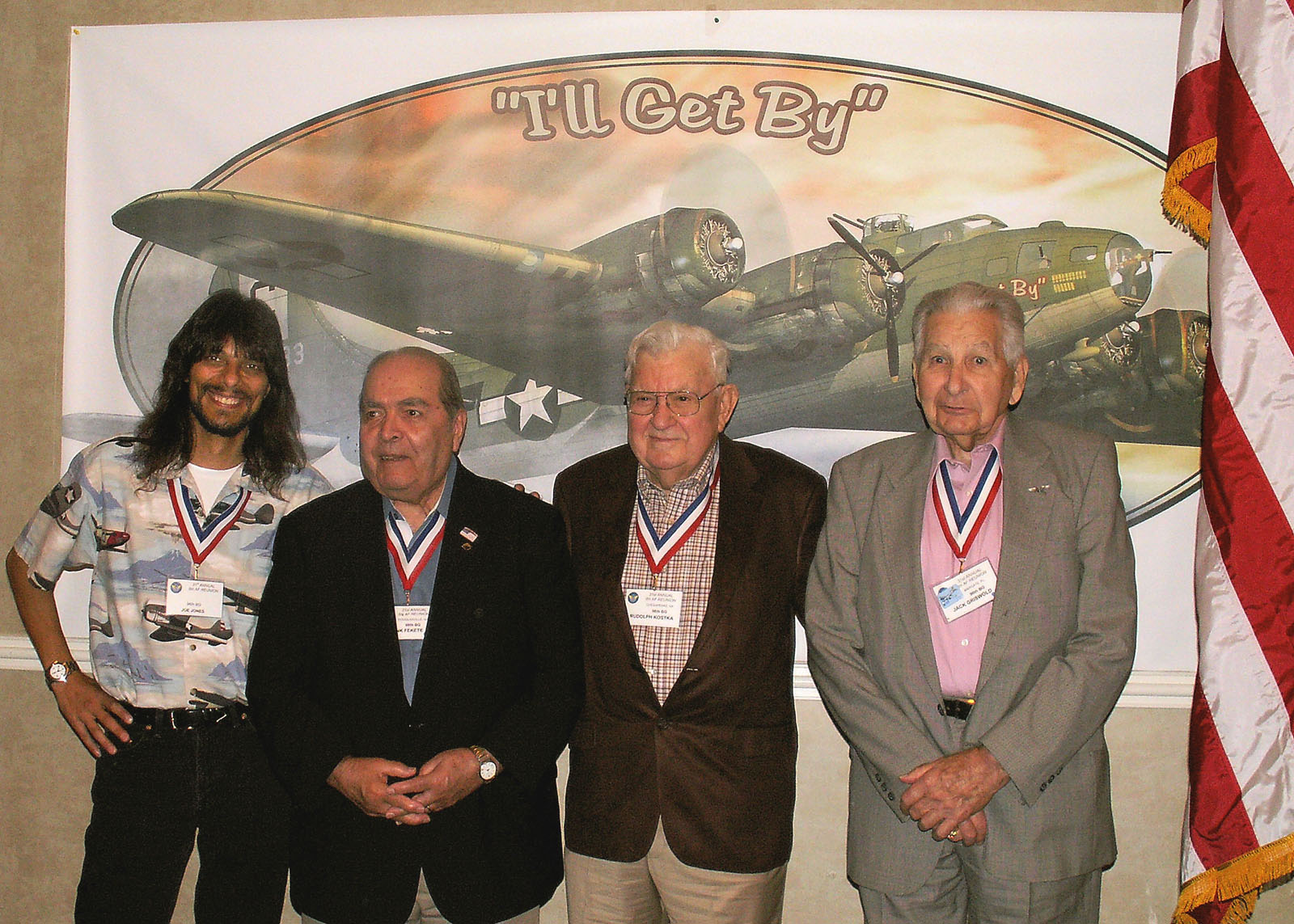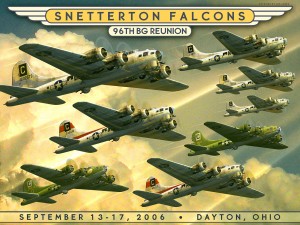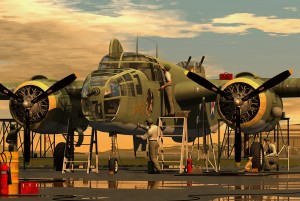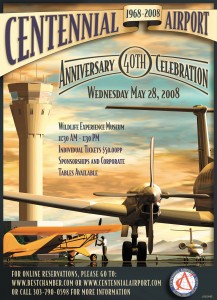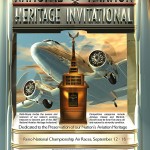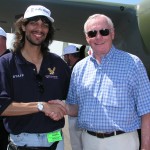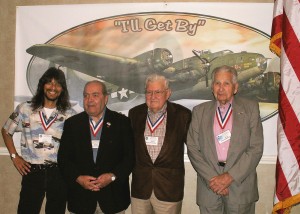
L to R: Joe Jones created this illustration of I’ll Get By, a B-17 flown by the 8th AF, 96th Bomb Group. With him are Frank Fekete, two-mission D-Day air veteran of the 96th BG, and his crew, ball-turret gunner Rudy Kostka and waist gunner Jack Griswold.
By Reggie Paulk
Even if you’ve never heard of Joe Jones, it’s quite likely you’ve seen his artwork. As a commercial aviation illustrator, Jones created the logo for Frontier Airlines. Looking at the logo, it’s almost impossible to see that it’s not a photo, but a digital rendering of an Airbus with the trademark elk on the tail. Jones isn’t best known for his commercial print work, though; it’s for his work involving the aircraft and crews of World War II.
A Colorado native, 44-year-old Jones has many dear friends who are nearly twice his age. He dedicates the majority of his artwork to the legacy of WWII veterans, and they’ve been a steady source of guidance and encouragement during his artistic odyssey.
“Two words that strike me as definitive of Joe are enthusiasm and dedication,” says Jim Rice, president of the Eighth Air Force Historical Society. “His artwork is impeccable, and his themes are extremely accurate to the events he portrays. He’s a highly talented and creative individual who’s taken those talents and applied them toward memorializing our WWII airmen.”
Jones’ exquisite paintings are the embodiment of the dangerous journey these men undertook for our great nation and the history they created in the process. The attention to detail in his paintings goes to a level few illustrators take the time to consider.
Harold B. Weekley, a retired Air Force colonel who flew the EAA’s B-17, Aluminum Overcast, for 23 years, said the B-17 is painted just like the airplane he was shot down in during WWII. His association with Jones began after seeing drawings of the plane.
“Joe continues to portray our most famous and popular aircraft in authentic and realistic settings,” he said. “He does it to such a degree that aviation enthusiasts everywhere feel privileged to own one of his paintings.”
Jones doesn’t paint using canvas—instead, he uses computer technology to create images with stunning beauty and depth of detail. His mouse and keyboard are his paintbrush and palette, while his computer screen is the easel. He’s personally developed many of the techniques used to create his masterpieces, and it’s no small undertaking.
In many ways, using a computer to create images is far more difficult than using a paintbrush. Instead of rendering images in two dimensions, Jones creates three-dimensional models of his subjects; this means he doesn’t just create the surface of an aircraft, but the inside as well.

“A Day in the Clouds” reflects the memories of the crew of Kipling’s Error III of the 8th Air Force’s 96th Bomb Group during the Oschersleben Raid of July 28, 1943.
His most difficult task is creating images that are faithful recreations of the events they depict. According to Jones, historical illustrations are either right or wrong.
“As soon as you understand that, you have to ask yourself what kind of artist you want to be,” says Jones. “Doing historic work is the biggest challenge an artist can undertake.”
As a way of explaining this challenge, Jones quoted G.K. Chesterton, a 19th century artist and writer: “The dignity of the artist lies in his duty of keeping awake the sense of wonder in the world.”
“If you think of that as a job title, how could you possibly live up to that?” asks Jones. “Day after day, week after week, your well-being depends on your ability to not only understand the concept, but to bring that concept to life.”
The historic responsibility he takes on makes it all the more difficult. Jones’ duty to the crews of the aircraft he illustrates shows up in the details of his paintings. Many may not take the time to count the number of rivets in a row on the side of a B-17, but Jones does.
“Joe takes great pride in his work and only produces the best,” says Jack Griswold, who crewed the waist gun in a B-17 of the 96th Bomb Group. The two-mission D-Day veteran calls every piece of art Jones has created for the 96th BG a masterpiece.
The use of color in Jones’ paintings is striking. Much thought goes in to exactly which colors he uses, depending on the message he’s trying to convey.
“Color has a whole psychology behind it,” says Jones. “I teach color psychology and how critical color is to how people respond. They can either be attracted to or repelled by a piece of art just by the use of color.”
Jones derives his color palette from the Depression era up through the 1950s.
“A lot of my color influence comes from the wartime propaganda posters,” he continues.
Jones’ signature elements include wonderful light rays.
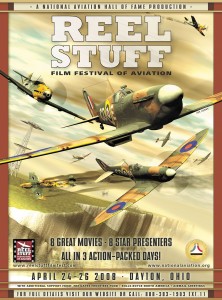
This poster, created for the Reel Stuff Film Festival of Aviation, depicts the harrowing action of the Battle of Britain and the instrumental role both radar and the Spitfire played in the outcome.
“Artists call them ‘God’s eyes,'” he said. “Renaissance art depicts spirituality with these lights. I use them as a metaphor for the spirits of all the fallen airmen during the war.”
The use of color is just one of many elements that determine the success of an artist’s work. According to Jones, an artist has to become a master of many disciplines, with a varied understanding of different types of knowledge.
“You have to become a philosopher and a poet,” says Jones. “You have to understand psychology, sociology and history, as well as how to relate to your audience. For example, the more sophisticated your audience, the fewer and more muted your colors must become.”
An artist can draw anything, but Jones aspires to be a storyteller with his art. He believes that telling the stories of our veterans is his calling.
“There are no greater stories worthy of being told,” he said.
He pointed out that a good piece of visual art can be very effective.
“Not only will it inspire and make an emotional and intellectual connection, but it can captivate the imagination and spirit and deeply influence a person,” he said.
Keeping busy
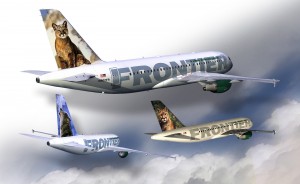
Joe Jones’ work with Frontier Airlines resulted in these photo-realistic renderings of their Airbus A-319 aircraft, complete with the Frontier animals.
Not one to rest on his laurels, Jones is currently involved in multiple projects that bring a daily challenge to his work. One of those projects is the first annual Reel Stuff Film Festival of Aviation (wwww.reelstufffilmfest.com), hosted by the National Aviation Hall of Fame from April 24-26. Academy Award winner Cliff Robertson will be among those presenting films.
Ron Kaplan, executive director of the National Aviation Hall of Fame and founding director of the Reel Stuff, said Jones was a natural choice for developing the marketing plan for the Battle of Britain-themed festival. He first met Jones through his affiliation with the Aviation Nation air show at Nellis Air Force Base and later worked with him on the National Aviation Heritage Invitational at Reno. With a background in graphic design, Kaplan immediately developed a great respect for Jones’ creative talent and for his commitment to authenticity and accuracy in the aircraft he was rendering.
“Coupled with his unique approach to design and his expertise in visual presentations, that really made for some spectacular work,” Kaplan said. “I knew Joe would be the perfect designer choice to execute our themed poster. He’s done that and exceeded my expectations with the piece that he’s produced for the Reel Stuff.”
Jones also created the artwork for the Centennial Airport (APA) 40th anniversary celebration (www.centennialairport.com/151) in Colorado. The event is scheduled for May 28; proceeds will benefit the Centennial Airport Foundation for Education.
Jones is now in his fifth year as the official event artist for the Rolls Royce National Aviation Heritage Invitational (www.heritagetrophy.com), held annually during the Reno National Championship Air Races & Air Show. This year is the event’s 10th anniversary. The artwork Jones created for the event will appear in several national publications.
Jones’ latest adventure has been to create a line of aviation-themed greeting cards through Airmail Greetings, a company he formed in order to fill a void in the marketplace. Through Airmail Greetings, Jones is offering his original creations in thank you, good luck, sympathy, holiday and WWII-themed variations.
To learn more about Airmail Greetings, visit www.airmail-greetings.com.
- Joe Jones’ depiction of Aluminum Overcast dazzles with its fascinating color. He created the poster for the B-17’s annual visit to Denver as part of EAA’s Fly the Fortress tour.
- The DC-3 in this poster, devised for the Rolls-Royce National Aviation Heritage Invitational, is so shiny you can see the reflection of the engine nacelle and clouds in the fuselage.
- Joe Jones spent time with Apollo 11 Commander Neil Armstrong on July 20, 2003, 34 years to the day Armstrong walked on the moon.











